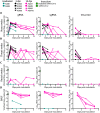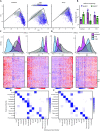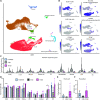Single-cell RNA sequencing reveals SARS-CoV-2 infection dynamics in lungs of African green monkeys
- PMID: 33431511
- PMCID: PMC7875333
- DOI: 10.1126/scitranslmed.abe8146
Single-cell RNA sequencing reveals SARS-CoV-2 infection dynamics in lungs of African green monkeys
Abstract
Detailed knowledge about the dynamics of severe acute respiratory syndrome coronavirus 2 (SARS-CoV-2) infection is important for uncovering the viral and host factors that contribute to coronavirus disease 2019 (COVID-19) pathogenesis. Old-World nonhuman primates recapitulate mild to moderate cases of COVID-19, thereby serving as important pathogenesis models. We compared African green monkeys inoculated with infectious SARS-CoV-2 or irradiated, inactivated virus to study the dynamics of virus replication throughout the respiratory tract. Genomic RNA from the animals inoculated with the irradiated virus was found to be highly stable, whereas subgenomic RNA, an indicator of viral replication, was found to degrade quickly. We combined this information with single-cell RNA sequencing of cells isolated from the lung and lung-draining mediastinal lymph nodes and developed new analysis methods for unbiased targeting of important cells in the host response to SARS-CoV-2 infection. Through detection of reads to the viral genome, we were able to determine that replication of the virus in the lungs appeared to occur mainly in pneumocytes, whereas macrophages drove the inflammatory response. Monocyte-derived macrophages recruited to the lungs, rather than tissue-resident alveolar macrophages, were most likely to be responsible for phagocytosis of infected cells and cellular debris early in infection, with their roles switching during clearance of infection. Together, our dataset provides a detailed view of the dynamics of virus replication and host responses over the course of mild COVID-19 and serves as a valuable resource to identify therapeutic targets.
Copyright © 2021 The Authors, some rights reserved; exclusive licensee American Association for the Advancement of Science. No claim to original U.S. Government Works. Distributed under a Creative Commons Attribution License 4.0 (CC BY).
Figures





Update of
-
SARS-CoV-2 infection dynamics in lungs of African green monkeys.bioRxiv [Preprint]. 2020 Aug 20:2020.08.20.258087. doi: 10.1101/2020.08.20.258087. bioRxiv. 2020. Update in: Sci Transl Med. 2021 Jan 27;13(578):eabe8146. doi: 10.1126/scitranslmed.abe8146. PMID: 32839775 Free PMC article. Updated. Preprint.
References
-
- Sungnak W., Huang N., Bécavin C., Berg M., Queen R., Litvinukova M., Talavera-López C., Maatz H., Reichart D., Sampaziotis F., Worlock K. B., Yoshida M., Barnes J. L.; HCA Lung Biological Network , SARS-CoV-2 entry factors are highly expressed in nasal epithelial cells together with innate immune genes. Nat. Med. 26, 681–687 (2020). - PMC - PubMed
Publication types
MeSH terms
Substances
LinkOut - more resources
Full Text Sources
Other Literature Sources
Medical
Molecular Biology Databases
Miscellaneous

